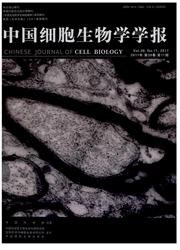

 中文摘要:
中文摘要:
细胞外基质中的纤维连接蛋白可以使细胞表面的整合素受体聚集起来,引起RhoA介导的信号通路的活化,从而导致细胞骨架的重组和细胞迁移的调节。然而,大部分纤维连接蛋白以可溶形式存在于血浆中,这些可溶性纤维连接蛋白是否有相似的效应仍有待于进一步的研究。实验发现,向细胞培养液中加入可溶性纤维连接蛋白,可使胃癌细胞系SGC-7901中的RhoA由GDP结合的非活性形式转变为GTP结合的活性形式,与其底物结合的量增加,而α5β1整合素的抗体可以阻断这一活化过程;可溶性纤维连接蛋白可诱导细胞聚合体形式的肌动蛋白(F-肌动蛋白)的形成。在人前列腺癌细胞系PC-3中,可溶性纤维连接蛋白可引起细胞从多角形向圆形的形态改变,α5β1整合素的抗体可阻断这一改变。以上结果显示可溶性纤维连接蛋白能与α5β1整合素结合并诱导RhoA介导的信号转导。
 英文摘要:
英文摘要:
It is well known that fibronectin within extracellular matrix can ligate membrane receptor integrin and induce RhoA mediated signals leading to reorganization of the cytoskeleton and regulation of cell migration. However, a big portion of fibronectin is dissolved in the plasma. Whether soluble fibronectin has similar effect needs to be elucidated. Here we show that adding soluble fibronectin to cell culture medium caused change of RhoA protein from inactive GDP-binding form to active GTP-binding form, with increased association with its substrate. Antibody against α5β1, integrin prevented the activation of RhoA protein. Soluble fibronectin induced F-actin formation of the ceils. In human prostate cancer cell line PC-3, soluble fibronectin caused morphological change from polygonal to round and antibody against α5β1 integrin prevented the change. The results revealed that soluble fibronectin could bind α5β1 integrin and induce RhoA mediated signal transduction.
 同期刊论文项目
同期刊论文项目
 同项目期刊论文
同项目期刊论文
 期刊信息
期刊信息
